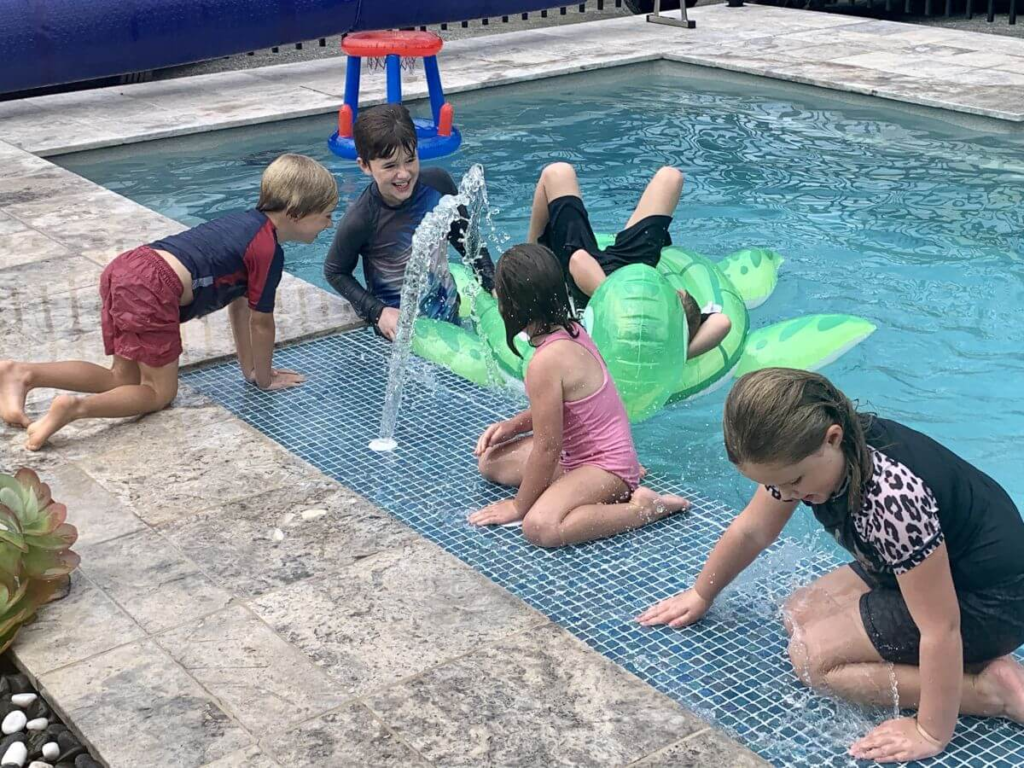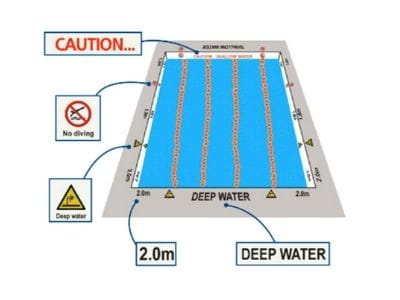How deep should the pool be?

Adding a swimming pool to your backyard can greatly enhance the value of your home and improve your overall quality of life. The process of envisioning a pool and exploring the possibilities of turning your dreams into reality is truly exhilarating. One crucial aspect of this process is determining the perfect depth for your pool. The ideal depth will depend on how you plan to use the pool, whether it's for peaceful relaxation, invigorating laps, or enjoyable family activities. The depth of your pool plays a pivotal role in shaping its final design, and considering pools of different shapes, sizes, and depths adds an extra layer of excitement to the decision-making process. So, what should be the depth of your dream pool?
Achieving the Ideal Pool Depth: Enhancing Your Swimming Enjoyment
When planning the depth of your pool, it is crucial to consider its intended use. Whether you envision a peaceful retreat for relaxation, a gathering spot for family fun, or a versatile space for swimming and diving, the depth of the pool should align with these purposes. Factors such as child safety, budget constraints, maintenance requirements, local regulations, and legal standards should all be taken into account when deciding on the ideal pool depth. Striking a balance between safety and enjoyment is key, as a pool that is too deep can pose risks, while a pool that is too shallow may limit swimming space. Typically, standard pool depths fall within the range of 107 to 244 centimeters (approximately 3.5 to 8 feet).
Customizing Pool Depth to Suit Your Individual Requirements
Determining the depth of your pool is not as straightforward as it may seem at first glance. It involves a complex decision-making process that takes into account various factors, including personal preferences. The primary factor that influences the depth of your pool is the intended use. Whether it is for relaxation, swimming exercises, or family fun, the ideal depth will vary based on these requirements. Additionally, the size and shape of your pool are crucial considerations in determining the perfect depth. Safety and usability should also be carefully evaluated to ensure that your pool meets your expectations.
Optimal Pool Depth for Maximum Comfort: Refresh and Unwind
For those envisioning a backyard pool as a retreat for relaxation and unwinding during the summer, a pool with a depth ranging from 91 to 152 centimeters (3 to 5 feet) is recommended. This depth allows for swimming, wading, and floating comfortably, creating a serene oasis in your own backyard. Additionally, this depth is suitable for light swimming exercises or swimming laps. While deeper pools have their advantages, they may not be the best choice for individuals seeking a tranquil space for relaxation, as they necessitate constant swimming and floating. To enhance the relaxation factor of your pool, consider incorporating a shallow area approximately 30 centimeters (1 foot) deep. This shallow section offers an ideal spot for sunbathing while remaining immersed in the refreshing water, making it a perfect location for sun loungers.

Pools designed for children: Ensuring safety and enjoyment
Creating a safe and enjoyable swimming pool for children involves establishing a shallow pool area. The depth of this section should range from 76 to 107 centimeters (2.5 to 3.5 feet) to ensure a secure environment for play and swimming. It is crucial to have a gradual slope leading to the deeper end of the pool and to avoid abrupt changes in depth, particularly for the safety of young swimmers. Family-oriented pools often feature multiple depth levels, but constructing a separate paddling pool specifically for young children enables them to enhance their swimming abilities in a protected space until they are proficient swimmers.

Engaging in Swimming and Aquatic Activities
If your pool is intended for active swimming and water sports, you have the option to adjust the depth accordingly. To ensure a pleasant swimming environment, aim for a depth ranging from 91 to 183 centimeters (3 to 6 feet). It is advisable to have a minimum depth of 122 centimeters (4 feet) to allow swimmers to move around comfortably.

Diving Safety Measures
When considering the addition of a diving board or slide to your pool, it is crucial to prioritize safety by adhering to FINA's international swimming and diving standards. According to FINA, pools used for diving should have a minimum depth of 5 meters (approximately 500 centimeters). This requirement specifically applies to competitive diving or high diving boards, ensuring that the diving section of your pool meets this standard. In addition to local government and national regulations, these FINA standards are implemented in international competitions to provide the utmost protection for diving safety. They encompass comprehensive safety measures aimed at preventing diving accidents and minimizing the risk of injuries. Diving in pools that do not meet the required depth can result in severe harm, underscoring the importance of complying with FINA standards when designing your pool.
Versatile Pool Layout: Depths Catering to All Requirements
If you plan on using your pool for various purposes, a pool that incorporates different depth zones can be an excellent solution. This multi-depth pool is designed to cater to both children and recreational users. The shallow section of the pool, which is approximately 61 to 91 centimeters (2 to 3 feet) deep, ensures the safety of children while providing a relaxing area for adults. Gradually transitioning into a deeper zone, this shallow area can reach a depth of about 183 centimeters (6 feet). The depth of the pool typically ranges from 61 to 183 centimeters (2 to 6 feet), but it can be customized to meet your specific requirements and preferences. For instance, if you prefer engaging in activities like active swimming or diving, a deeper area can be incorporated. By offering a safe play area and a suitable space for swimming and sports activities, this pool provides the best of both worlds.

Considerations for Determining Pool Depth
When deciding on the depth of your pool, it is important to take into account various factors, including the intended use of the pool.
Care and Maintenance: Deeper pools require more water maintenance, which means increased maintenance tasks. Ensure that you are prepared to handle the upkeep of a deep pool.
Safety First: For the safety of children, the shallow end of the pool should ideally be between 76 to 107 centimeters (2.5 to 3.5 feet) deep. Deep pools can pose risks to children and individuals with limited swimming abilities.
Financial Planning: Keep in mind that deeper pools can lead to higher costs due to additional excavation, materials, and labor. Consider your budget carefully when determining the depth of your pool.
Space Constraints: Take into consideration the size and layout of your backyard when choosing a pool depth. Smaller or oddly shaped yards may require more compact pool options.
Regulatory Compliance: Always check local laws and regulations before finalizing the depth of your pool. While a 457-centimeter (15-foot) deep pool may seem appealing, it may not align with local ordinances. Contact your municipality or government to ensure that your pool depth meets legal requirements.
Significance of Pool Depth
The depth of a swimming pool plays a crucial role in ensuring safety and enhancing the overall user experience. Finding the appropriate depth is essential in minimizing accidents and creating a pleasant environment for swimmers of all levels. For instance, a pool that is too shallow can pose a risk of hitting the bottom for divers, whereas a pool that is too deep may be hazardous for beginners. Therefore, striking the right balance in depth is key to catering to the diverse needs of swimmers.
Accurate Pool Depth Measurement
It is crucial to measure the depth of your pool accurately in order to evaluate its water capacity, determine the necessary amount of chemicals, and estimate the expenses associated with maintenance.
1. The depth of the pool is a crucial consideration based on its intended use. For recreational purposes, a depth of 91 to 152 centimeters (3 to 5 feet) is recommended, while 91 to 183 centimeters (3 to 6 feet) is ideal for active swimming and water sports. A depth of 76 to 107 centimeters (2.5 to 3.5 feet) is suitable for children's safety.
2. To ensure the safety of children, the shallow end of the pool should have a depth ranging from 76 to 107 centimeters (2.5 to 3.5 feet). This depth provides a secure area for children to play and swim without any risks.
3. Factors such as child safety, budget, maintenance needs, space constraints, and local regulations should all be taken into account when determining the appropriate depth of the pool.
4. According to FINA standards, a pool depth of at least 5 meters (approximately 500 centimeters) is required for diving. This standard is particularly important for competitive diving and high diving boards. 5. Accurately measuring the pool depth is essential for calculating water capacity, determining chemical requirements, and estimating maintenance expenses.
6. In the case of small or irregularly shaped gardens, it is advisable to opt for smaller pool options that fit within the spatial constraints of the area.
7. Pool depth plays a crucial role in ensuring safety, comfort, and overall swimming experience. Choosing the wrong depth can increase safety hazards and impact the enjoyment of swimmers.

